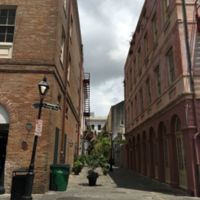Exchange Place
Title
Exchange Place
Memorialization of Urban Slavery in Southern Coastal Cities
Subject
slavery; memorials
Description
Exchange Place, or Exchange Alley, was the corridor that connected the American to the French sectors of town. It was created as a result of the 1829 law against keeping slave depots and jails in the French Quarter. Slaves would be led through the alley directly from Canal Street to the St. Louis hotel for auctioning.
This project was funded by Bernard and Anne Spitzer Travel Fellowship for research projects involving travel abroad and incorporating the study of architecture, landscape architecture, or urbanism.
My goal was to research, witness, and record how each of my chosen Southern port cities has dealt with its past in regards to urban slavery, and to begin making a record of this history. Although all of the locations I visited were major hubs of the American slave trade, these cities remain mostly lacking in admitting their full and complete history. The inaccurate and incomplete narratives, lack of memorials, and white-washed histories designed to appeal to the tourist industry do not tell the stories of the slaves in an unbiased and forthright way. So much of what I witnessed revolved around a very racially divided tourist industry, but I know that change is possible. The story of urban slavery is not just the story of African Americans in the United States, but the story of all of us, and the more we can understand this, the better off we all will be.
Creator
Whang, Maura
Rights
This image is under copyright. You need to contact copyright owners for any commercial or non-commercial uses. Contact information: digital@ccny.cuny.edu.
Whang, Maura
Type
Architecture and City Planning
Identifier
T0597
Coverage
New Orleans, LA
Files
Citation
Whang, Maura, “Exchange Place,” Spitzer School of Architecture, accessed November 17, 2024, http://digitalscholarship.ccny.cuny.edu/architecture/items/show/1142.
Item Relations
This item has no relations.

